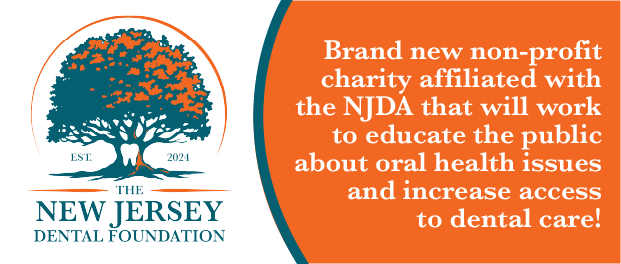Perfect Smiles Start With You
Smile Design Boot Camp is an intensive 4-day course that equips dentists with the confidence and knowledge to incorporate techniques for single-arch and full mouth rehabilitation into their practice. Sign up to secure a spot!
It's a NEW Convention!
Registration is now open for NJDA’s Annual Convention in Bridgewater on May 16-17! Our annual gathering of the NJ dental community will feature top-tier CE courses on a wide range of topics, a rooftop party, and more.
The Party of the Year!
The NDJA Celebration on May 16 is going to be huge! We are taking over the entire 7th floor of the AC Hotel including three bars, outside patio, pool table, DJ and dance floor!
New Jersey Dental Foundation
Take a moment to learn more about NJDA's brand new initiative to help the public learn more and gain access to oral healthcare! Read the mission statement, governance, structure and more.
This is membership your way
Renew today to explore new lower membership costs and customization offerings.
Helping Members Succeed
The New Jersey Dental Association is the voice of the dental profession and a strong proponent of oral health in the state. Members are part of a vibrant community of dentists encompassing 12 local dental societies as well as the American Dental Association. Members engage in educational programs, have access to dentist-centric relationships and tools to navigate the business of dentistry and their careers, as well as benefit from dedicated advocacy that protects the interests of the profession. The organization is run by member-dentists with the support of a team of professionals at NJDA Headquarters. NJDA members never practice alone!
UPCOMING EVENTS
DENTAL NEWS AND NOTES

Handle With Care: Minimizing Risk With Short-Term and Traveling Patients

You likely have invested considerable time and money in a marketing plan that attracts new patients to your office, along with energy and resources to ensure those patients are retained. Building a thriving practice and growing your patient base is even more rewarding when new patients are rereferred to you from satisfied existing patients or other trusted health care providers and peers.
Some of these patients come with baggage — quite literally! A variety of situations can prompt patients who are not local to seek dental care while they are temporarily visiting or residing in your area. Some may have an established provider in their primary residential area but are experiencing an unexpected dental emergency or trauma. Others may be attempting to maintain an established treatment plan or receive preventive care while temporarily living away from their regular dentist. These patients may include:
- Business travelers who are on extended work trips in your city.
- Students at local colleges, universities or boarding schools.
- “Snowbirds“ or others who live in one area seasonally then return to their permanent residence for the rest of the year.
As the “emergency“ general dentist, you may be handling more difficult procedures but are unable to ensure continuity of care, follow-up treatment and maintenance once the patient leaves your office. An additional complication is that you have not had the opportunity yet to build a climate of trust with this short-term patient — an important step in the provider-patient relationship that increases communication and improves outcomes. So how can you care for temporary or traveling patients while protecting your practice from elevated risk factors? The Dentists Insurance Company’s dedicated Risk Management analysts provide guidance to inform complex decision-making and help you navigate patient selection and documentation.
A case study in treating an out-of-town patient
A phone call received by TDIC’s Risk Management Advice Line involved a retiree patient who enjoyed spending summers in the milder coastal climate of Northern California but preferred spending the winter months in Arizona. The patient did not disclose this information about her sun-seeking lifestyle to the dentist she saw in California. When she began experiencing tooth pain, the California dentist treated her and placed a provisional crown, advising the patient to return in two weeks for a permanent restoration.
The patient failed to return until months later; by that time, the tissue around the tooth was inflamed and the tooth had developed slight mobility. The dentist advised the patient of the tooth’s guarded prognosis during this second appointment. The patient chose to have the previously fabricated crown placed, but the crown did not fit and needed to be remade. Upon hearing the news that this would extend the treatment time, the patient stated she would soon be leaving town. The treating dentist asked the lab to rush the case so the patient’s treatment could be completed prior to her departure.
A few weeks after the permanent crown had been delivered, the California dentist heard back from the patient, who was now living in Arizona. She reported that the tooth had fractured at the gumline. With the patient living so far away, limiting her return for follow-up care, the dentist sought advice from TDIC’s Advice Line for how to handle the situation ethically and effectively.
The Risk Management analyst advised the dentist on the importance of patient and case selection as well as spending more time with patients during initial visits to gain knowledge about their dental history and lifestyle. Recognizing that the patient’s difficulty with receiving continuity of care from his practice was overlooked in previous visits, the dentist was willing to offer the patient a partial refund to offset the cost of care. The analyst reviewed guidelines for offering the patient a refund and reminded the dentist to encourage the patient to establish care with a dentist in her current location as soon as possible. Such a reminder should be offered in writing to establish a body of evidence.
The importance of patient selectionAs much as you want to welcome new patients, remember that dentists are not obligated to accept all patients into their practice (barring discrimination). Those you do select to make up your patient base should generally be those with whom you can form productive, healthy provider-patient relationships. When patients come to you on an as-needed basis and you are not in the position to perform routine exams or radiographs, it is difficult for you to ensure continuity of care, proper diagnoses, treatment and maintenance — all factors that increase risk.
With that in mind, you may sometimes choose to weigh the benefits of temporary patient care against those known risks. Potential patients may warrant extra consideration when they have been referred to you by current patients or trusted colleagues. Providing care to these patients promotes a positive working relationship between you and the referrer and ensures you will continue to get referrals from them on an ongoing basis — not all of which will be temporary.
Online reputation management is another factor that should be considered when deliberating accepting a temporary patient. If the patient reached out to your office due to positive provider reviews discovered online, they are more likely to leave a review of their own. Such reviewers have been known to leave negative feedback based on their interaction with office staff when initially seeking care.
Because your office staff are the first point of contact with any potential patient, they should be trained to offer thoughtful, compassionate service to anyone who requests an appointment. If you choose to accept emergency or short-term patients on a case-by-case basis, be sure your office staff understands the process for case review and how to communicate that process to those seeking emergency care. The ethical standard for emergency services for patients who are not patients of record is to make “reasonable arrangements for their emergency care,“ according to the ADA Principles of Ethics and Code of Professional Conduct. To facilitate meeting this standard, TDIC suggests maintaining a list of phone numbers of clinics and dental societies to provide to emergency patients who don’t have an established dental provider.
Considerate communication and documentationRespectful communication and careful documentation at all points of service protect your practice’s reputation and mitigate risk. Questions on your intake forms are a good place to begin this documentation. Asking “What is the reason for your visit today?“ and “When was your last dental visit and what was the name of the dentist?“ are appropriate ways to identify short-term patients. Should you decide to accept a short-term or traveling patient, here are an additional five critical points of communication and documentation:
- Whether or not the patient has a regular dentist. If they do, make every effort to consult directly with that provider. Request any recent notes or radiography that pertain to the current treatment.
- The patient‘s detailed medical and dental histories. This is particularly important if you are unable to obtain records from another dentist on behalf of the patient. Document past medical and dental procedures, current diagnoses and any medications.
- The patient‘s lifestyle. To get a complete picture of health, inquire about and document aspects of the patient’s lifestyle that may impact their care. This includes travel plans and any impediments to consistent access to care.
- Informed consent. As with all patients, informed consent is a discussion, not just a form. Acknowledge their understanding and consent before offering any treatment. Short-term patients should also be notified of the risks posed by postponing follow-up care.
- The length of treatment. If an out-of-town patient presents with a particularly complex case, it’s best not to get involved beyond palliative care. Patients who are visiting or living temporarily in your area may not have the opportunity to complete treatment under your care. Explain the importance of continuous care to the patient and encourage them to schedule a consultation with their primary dentist.
Treating “snowbirds,“ college students or patients who present only on an emergency basis can be challenging, especially when another general dentist is their primary care provider. As the “secondary“ general dentist, you have more liability exposure than the dentist who is performing their routine dental care. Again, the best defense is good communication between the dentist and patient and between the two treating dentists. Be sure to proactively explain to the patient the importance of continuous care with one practitioner. And if the situation becomes too complex, ask the patient to choose who will be their primary dentist. If the patient is unwilling to do so, then it’s best to consider terminating care.
Trust your instincts and have the confidence to say no to cases that make you uncomfortable. If you find yourself facing a challenging or uncertain patient care situation, consult an experienced TDIC Risk Management analyst.
For use by the California Dental Association components, the Arizona, Hawaii, Idaho, Nevada, New Jersey, North Dakota, Oregon, Pennsylvania and Washington dental associations, the Alaska Dental Society and the Illinois State Dental Society. If you wish to reprint this article, contact TDIC in advance by emailing info@tdicins.com. If you would like to request edits to this article prior to publishing, include the suggested changes in your email.
Contact Us
Phone: 732-821-9400 or dial the Staff Directly
Fax: 732-821-1082 | Email: info@njda.org | Follow us @NJDentalAssoc
One Dental Plaza, North Brunswick, NJ 08902













